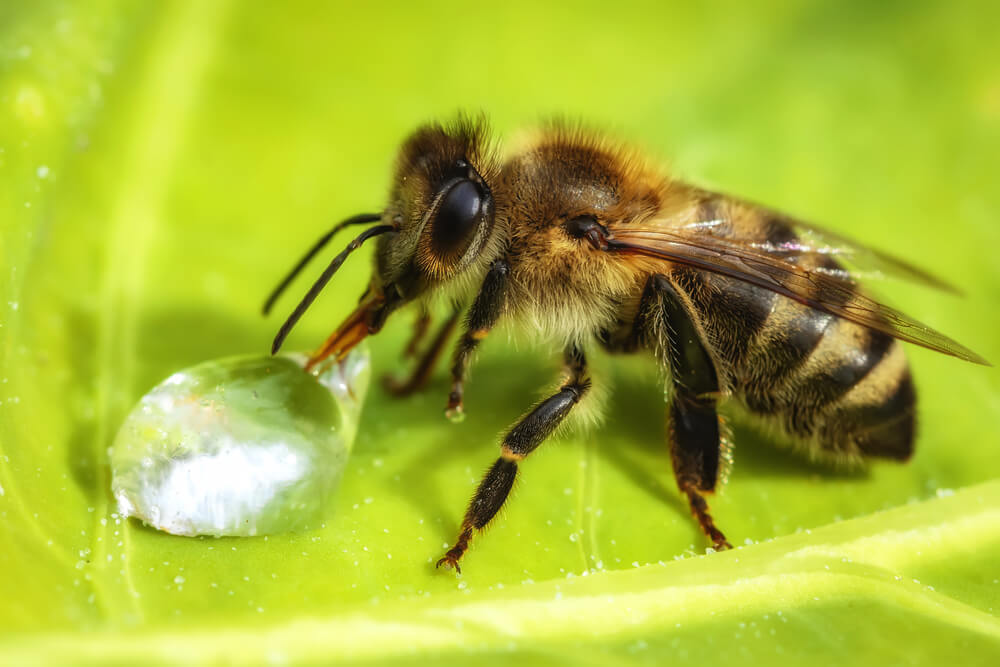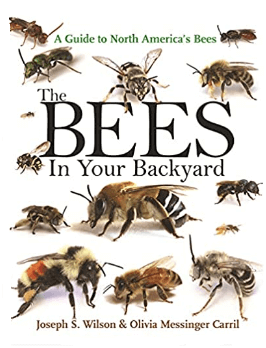What is a Baby Bee?
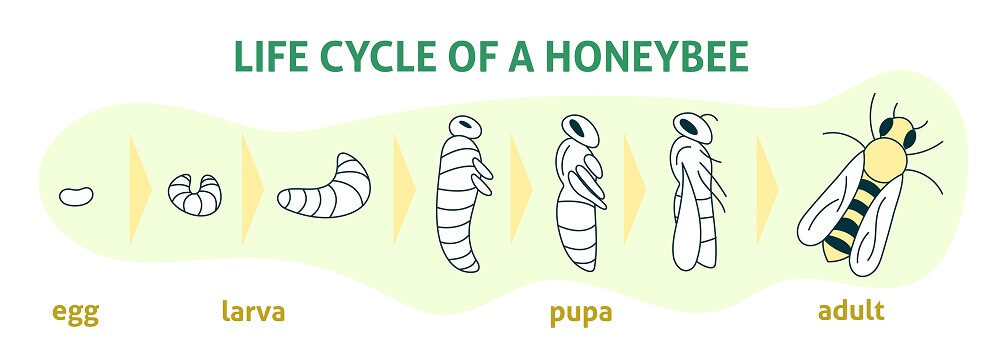
The term “baby bee” refers to bees when they’re still in larva or pupa form.
Bees go through four stages of development:
- Stage 1: Egg
- Stage 2: Larva
- Stage 3: Pupa
- Stage 4: Adult bee
Baby bees “hatch” from eggs laid by the queen bee. Bee eggs look like tiny grains of white rice. Depending on the bee species, it can take three to four days for the bee egg to hatch into a larva.
The term “hatch” is used loosely here because the egg’s outer shell doesn’t crack like a bird egg. Instead, it gradually dissolves, which allows the larva to emerge.
The larva is the second stage of development that a baby bee goes through.
Bee larvae look like small white grubs. They haven’t developed their wings, eyes, or legs at this stage yet.
So what do bee larvae do?
They eat. And eat. And eat some more.
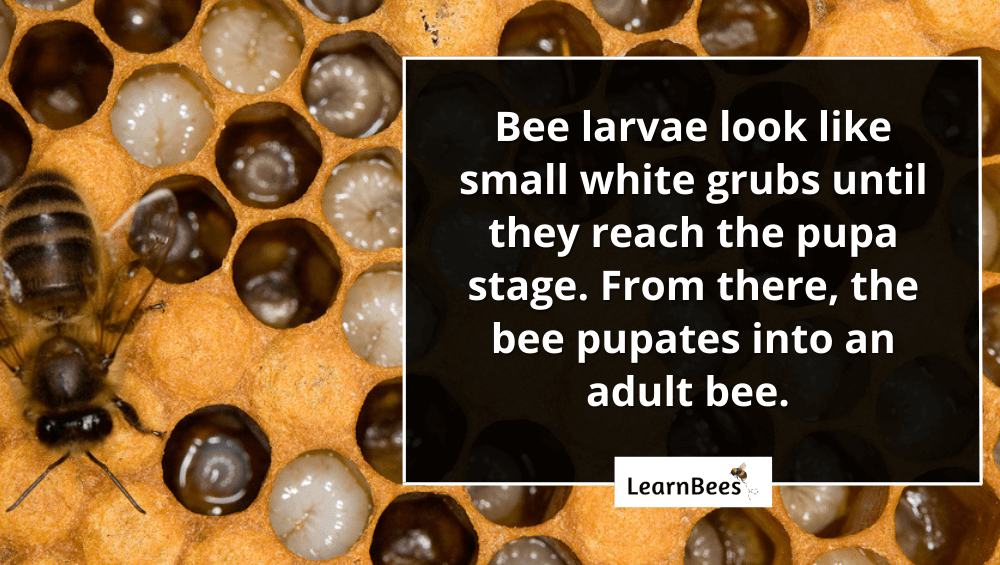
A baby bee’s main job at the larva stage is to consume as much food as possible so it can grow. As a result, worker bees feed larvae pollen, nectar, and honey. As larvae develop, they shed their skin multiple times.
After about six days in the larva stage, the baby bee will stop eating and start spinning a cocoon.
This is known as the pupa stage, which is the last development period before becoming an adult bee.
In the pupa stage, the tiny insect hidden under the capping is beginning to resemble an adult bee. Its wings, eyes, and legs start to develop. It grows the little fuzzy hairs that coat its body.
Bees spend between seven to fourteen days in the pupa stage, depending on the type of bee. Once the baby bee has completely formed, it chews its way through the wax cell and emerges as an adult bee.
Can Baby Bees Sting?
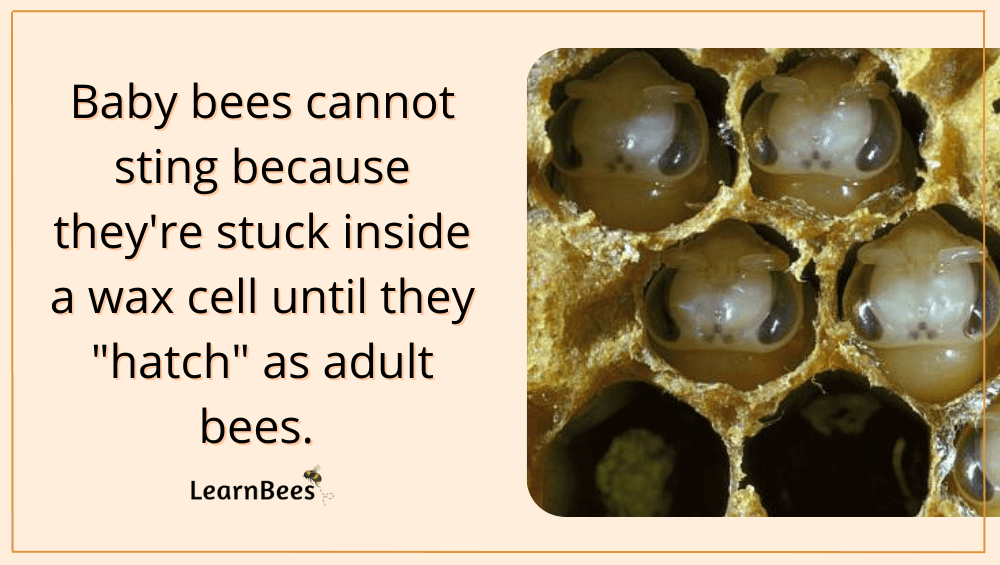
No. Baby bees can’t sting, fly, or fend for themselves until they officially “hatch” as adult bees.
And you might be surprised to learn:
Not all bees can sting.
In fact, only female bees can sting. Stingers are a modification of the ovipositor, which is an egg-laying organ. Since male bees don’t lay eggs, they don’t have stingers.
But that doesn’t stop them from putting on a good show.
Male carpenter bees, for example, will fly at predators to intimidate and scare them away. Some people call this the “dive bombing” technique. However, it’s just for show. Male bees can’t sting.
Additionally, there are types of bees that are stingless. Stingless bees are most commonly found in tropical areas such as Australia, Africa, and South America.
Female stingless bees do have stingers. But, their stingers are too small to be considered useful.
What Do Baby Bees Eat?
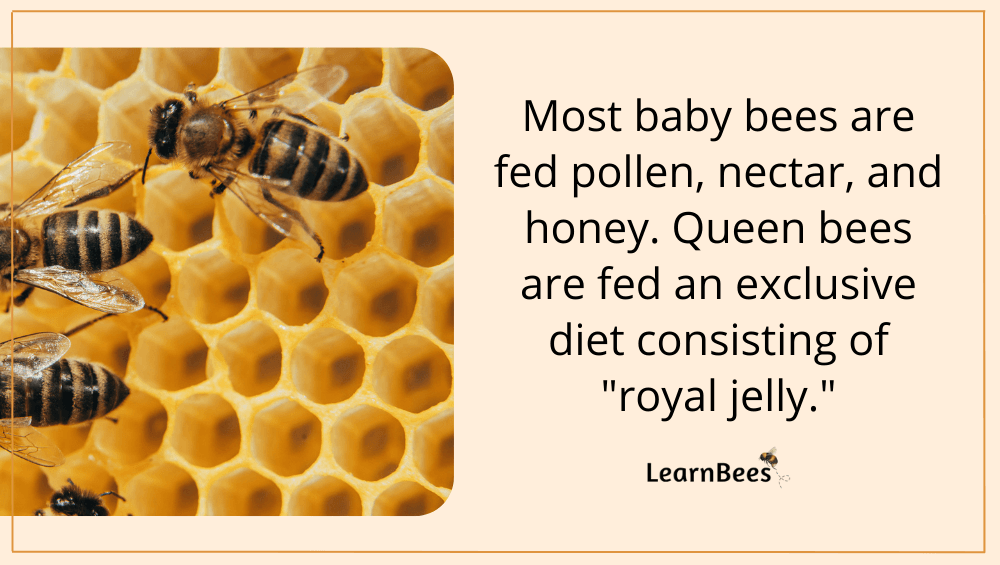
Short answer:
It depends on the type of bee.
For example, queen honeybees are fed a special diet of “royal jelly.”
Royal jelly is a highly nutritious substance rich in protein, simple sugars, fatty acids, and other trace minerals. This special diet allows the queen baby bee to grow larger and lay fertilized eggs.
In contrast, worker honeybees are fed a combination of royal jelly, pollen, and honey.
Pollen is a powdery substance that’s full of protein and other nutrients. Honey is a sugary substance that’s rich in carbohydrates. This diet allows the worker baby bees to develop into adults that can fly and collect pollen and nectar for the colony.
The baby bee’s diet helps determine which role it’ll have in the colony.
FAQs on Baby Bees
- What is a kid bee called?
- What do newborn bees look like?
- What are the tiny bees called?
- What are baby bumblebees called?
- What do baby bees eat?
- Can baby bees fly?
- Do baby bees sleep?
- Do baby bees bite?
- Do baby bees sting?
- How long does it take for baby bees to hatch?
- How many types of baby bees are there?
- Can you take care of a baby bee?
- Do baby bees swarm?
- What do baby bees look like?
- How are baby bees born?
What is a kid bee called?
For honeybees, baby bees are called “brood.” Brood refers to the eggs, larvae, and pupae of honeybees. In a honeybee hive, beekeepers place brood boxes at the bottom of the hive. The brood box is where the queen bee lays her eggs.
Most bees have a short lifespan of only a few weeks, so the brood box is essential for the continued survival of the colony.
This is why queen honeybees can lay up to 2,000 eggs per day. She works daily to replenish the colony’s population since they can lose up to 1,000 worker bees daily.
—> Go back to the FAQs on baby bees
More to Explore:
What do newborn bees look like?
Bees actually emerge as full-grown adult bees. They don’t look like “newborn” bees in size or shape. This is because bees go through three stages of development before becoming adult bees.
The process starts with the queen bee laying eggs. Bee eggs are very small, resembling grains of white rice. Depending on the bee species, they remain inside their eggs for three or four days.
The next stage of development is the larva stage.
Once the bee larvae hatch from their eggs, they look like small grub worms. Bee larvae cannot see, hear, or smell. They spend all of their time eating and growing. After about six days, the bee larva spin cocoons around themselves and enter the pupa stage.
The final stage of development is when the adult bee emerges from the pupal cocoon. Once the adult bee is ready, it will chew its way out of the wax cell. At this point, the bee is fully grown and ready to take on its adult responsibilities.
—> Go back to the FAQs on baby bees
More to Explore:
What are the tiny bees called?
Fun fact:
There are more than 20,000 species of bees. So, there isn’t just one answer to this question.
For example, the honeybee is just one type of bee. Honeybees live in social colonies filled with other bees. They’re medium-sized bees that are fuzzy. They also have yellow and black stripes.
You can easily spot honeybees around flowers like salvia, sunflowers, and veronica.
Another type of bee is the carpenter bee. Carpenter bees are quite a bit bigger than honeybees, sometimes measuring up to one inch long. Carpenter bees are easy to spot thanks to their large size.
Carpenter bees hang around wooden structures like homes, porches, and decks.
One of the smallest types of bees is the sweat bee. They get their name because they’re attracted to the salt in human sweat. Sweat bees are only about one-fourth of an inch long.
Unlike honeybees and bumblebees, sweat bees are shy. They’ll fly away quickly if you move abruptly or get too close to them while they’re pollinating flowers.
—> Go back to the FAQs on baby bees
More to Explore:
What are baby bumblebees called?
Baby bumblebees have no special name given to them. Most entomologists (insect scientists) refer to them as eggs, larvae, or pupa, depending on their development stage.
Like all bees, bumblebees go through three stages of development before becoming adults:
- Stage 1: Egg
- Stage 2: Larva
- Stage 3: Pupa
Bumblebee eggs resemble small grains of white rice. Bumblebees remain in the egg stage for about four days. From there, the bumblebee egg hatches into a larva. After about two weeks, the larvae spin cocoons and pupate.
Finally, the adult bumblebee emerges.
—> Go back to the FAQs on baby bees
More to Explore:
What do baby bees eat?
Baby bees eat different diets depending on the type of bee.
For instance, queen honeybees and worker bees have different diets.
Queen bees eat a diet of royal jelly. Royal jelly is a secretion produced by young nurse bees. It’s a highly nutritious substance that helps the queen bee develop and grow so she can eventually lay fertilized eggs. Royal jelly is rich in protein, vitamins, and minerals.
On the other hand, worker baby bees consume a diet of royal jelly, pollen, and honey. Worker bees aren’t exclusively fed royal jelly like queen bees are. Instead, they’re given a diet that contains a mixture of many things.
—> Go back to the FAQs on baby bees
More to Explore:
Can baby bees fly?
No, baby bees cannot fly because they’re kept inside a wax cell until they’re ready to emerge as adult bees. This means they’re limited in their movement.
However, once the bee emerges as an adult, it can fly. Adult bees use their wings to fly from flower to flower while they pollinate. Flight is a bee’s primary method of travel since they often have to go long distances in search of flowers.
—> Go back to the FAQs on baby bees
More to Explore:
Do baby bees sleep?
We do not know much about the sleeping habits of baby bees while they’re in the larva and pupa stages. However, we do know that adult bees sleep, and younger adult bees tend to sleep more than older adult bees.
Younger adult bees tend to take several “cat naps” throughout the day, while older adult bees have a more consistent nightly sleep routine.
—> Go back to the FAQs on baby bees
More to Explore:
Do baby bees bite?
No, baby bees don’t bite because they’re stuck inside a wax cell. They cannot fly, walk, or move around until they fully emerge as adult bees. This means baby bees are limited in what they can do before they emerge.
Once a baby bee finishes the pupa process and emerges as an adult bee, it can bite or sting predators if necessary.
—> Go back to the FAQs on baby bees
More to Explore:
- Ground Bees: Are They a Threat to Your Yard?
- Wasps vs. Honeybees: Are They Different?
- Do Bumble Bees Bite?
Do baby bees sting?
No, baby bees don’t sting because they’re confined inside a wax cell. As a result, they’re limited in their movements until they fully emerge as adult bees.
Once the bee finishes the pupa stage of development, it chews its way out of the wax cell and is officially considered an adult bee.
However, not all adult bees can sting. Only female bees can sting. Male bees do not have stingers.
—> Go back to the FAQs on baby bees
More to Explore:
How long does it take for baby bees to hatch?
There are more than 20,000 different species of bees, so the time it takes for them to hatch varies.
It takes honeybees about three days to hatch from an egg into a larva. But the process isn’t complete just yet. Baby honeybees stay in the larva stage for several days before moving onto the pupa stage.
Once the pupa stage is complete, the baby honeybee then becomes an adult.
—> Go back to the FAQs on baby bees
More to Explore:
- Do Carpenter Bees Pollinate?
- How Long Do Bumble Bees Live?
- Honeybees vs. Bumblebees: How Do They Compare?
How many types of baby bees are there?
There are over 20,000 different species of bees, including carpenter bees, mason bees, honeybees, and bumblebees. Each of these bee species goes through being “baby bees.” They start as eggs, become larva, then develop into pupa.
Once the pupa phase is complete, the bees are officially considered adult bees and emerge from their wax cell.
Additionally, there are also different types of baby bees amongst species. For example, there are baby queen bees, baby worker bees (females), and baby drone bees (males).
—> Go back to the FAQs on baby bees
More to Explore:
- Do Queen Bees Eat Honey?
- Are Worker Bees Male or Female?
- Queen Bee Versus Worker Bees – How Do They Compare?
Can you take care of a baby bee?
No, humans cannot take care of baby bees. The tending to of baby bees is left up to the worker bees. A bee colony operates like a well-oiled machine, with every bee performing its specific duty. There are special worker bees who are tasked with feeding and tending to the baby bees.
—> Go back to the FAQs on baby bees
More to Explore:
Do baby bees swarm?
No, baby bees are stuck inside a wax cell where they are going through their development stages. They are not outside flying around, collecting food, or swarming.
—> Go back to the FAQs on baby bees
More to Explore:
What do baby bees look like?
Baby bees look like small white grubs in the larva development stage. They start looking like adult bees once they enter the pupa stage. The pupa stage is where the bee forms its eyes, legs, wings, and body hair.
—> Go back to the FAQs on baby bees
More to Explore:
- Bees Color: 10+ Types of Colored Bees With Pictures
- 5 Famous Cartoons About Bees
- What Sounds Do Bees Make?
How are baby bees born?
Bees are not born like humans. They don’t come out of a mother’s womb. Instead, bees go through three development stages before emerging as adult bees.
The three development stages are:
- Egg – The egg is the first stage of a bee’s life. Once a female bee mates with a male bee, the female bee will lay eggs inside a wax cell.
- Larva – The larva stage is when the egg hatches and the baby bee starts to grow. The baby bee will stay in this stage for several days as it grows larger.
- Pupa – The pupa stage is when the baby bee starts to take on the features of an adult bee. This includes growing its eyes, legs, wings, and body hair.
